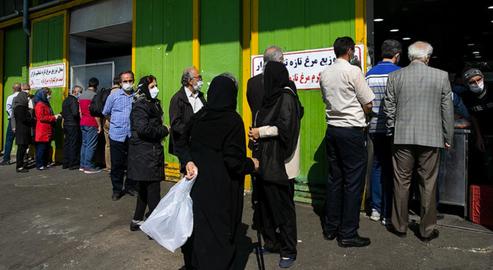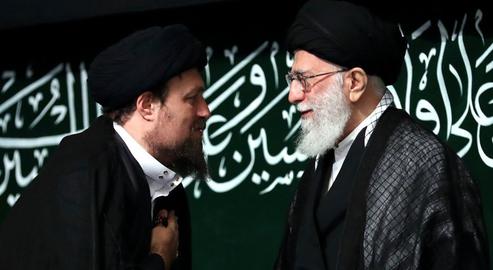Even the most pessimistic observer could not have imagined that Iran’s economic crisis would reach a point that a “chicken crisis” – a shortage of poultry – would emerge as the country’s most pressing economic and social issue at the start of the new Iranian calendar year. Nowhere else, not even the world’s poorest countries, has anything like this vulgar-sounding crisis with its long lines, empty fridges, black market trading and desperate sellers and buyers, and its confused officials. But the chicken crisis has emerged as a painful reality in Tehran and Iran’s other major cities.
Some are under the illusion that the chicken crisis is caused by a shortage of foreign currency for importing poultry feed, a reported 100% rise in the price of feed since November 2020, a fall in production, increases in demand or profiteering by unconscionable merchants. But the reality is something different. What is happening today in Iran is the result of the authorities running the country based on a fantasy called the “resistance economy”.
But what is the relationship between the chicken crisis and the resistance economy?
A Disaster Called the “Resistance Economy”
The “resistance economy” has been Supreme Leader Ayatollah Ali Khamenei’s prescription for countering international sanctions in the past 11 years. He first used this term in a speech on September 7, 2010, and presented it as the most effective way to foil sanctions. “The purpose of sanctions is to exhaust the people of Iran so that they would say ‘We are under sanctions because of the government of the Islamic Republic,’” he said. “They [Iran’s adversaries] want to do this so that they can break the relationship between the people of Iran and the Islamic Republic. This is their main goal ... We should [therefore] develop a form of resistance.”
Khamenei has since used the term more than 200 times in his speeches – about 20 times a year. His theme each time is that Iran must protect itself against sanctions by becoming self-sufficient, making imports and the revenue from oil exports unnecessary, thereby resisting economic sanctions by making them ineffective against Iran’s national economy.
On February 29, 2014, Khamenei announced the general outline of policies designed to build the resistance economy, saying that, by following a “native economic model,” Iran could not only “prevail over all economic problems, defeat the enemy and force it to retreat,” but could also provide an inspiring model of an “Islamic economic system” for other countries.
The “resistance economy” has since been the model that the Islamic Republic has pursued. But its disastrous consequences in practice show how a relatively healthy economy and a dynamic society can be ruined by self-imposed isolation.
Consequences of the Resistance Economy
Indicators show that one decade of the so-called resistance economy has resulted in zero economic growth and the loss of a fifth of the average individual’s purchasing power. Most of the world has seen economic growth during much of that same decade.
If we compare Iran’s per capita income with that of its northwestern neighbor, Turkey, for instance, Iranians have lost approximately 50 percent of their purchasing power compared to Turks.
Comparisons aside, the damage inflicted by the resistance economy within Iran has also been considerable. As defined by the United Nations in 1995, absolute poverty is “a condition characterized by severe deprivation of basic human needs, including food, safe drinking water, sanitation facilities, health, shelter, education and information. It depends not only on income but also on access to social services.” Official statistics show that, in recent years, absolute poverty has affected most of society and, according to official estimates, between 50 to 70 percent of Iranians regularly face hunger and malnutrition.
The average level of salaries and wages are also at historic lows and household budgets are at their lowest levels in recent years. Family’s food purchases are also at their lowest levels and the production of meat since 2019 has fallen to an unprecedented low – even lower than what it was during the Iran-Iraq war in the 1980s.
All these numbers are based on official statistics and indicators. But not a single day goes by without the emergence of a new crisis such a “meat crisis,” a “cooking oil crisis” and now the “chicken crisis,” all of which implicate the resistance economy as the culprit.
The Resistance Economy and the “Chicken Crisis”
Iran’s poultry industry is heavily dependent on imports. From importing mother hens to acquiring poultry feed, such as corn and soybean meal, if the supply chain and imports are disrupted then the poultry industry suffers severe consequences. The supply of chicken to the public suffers as a result. But instead of securing the external supply chain for Iran’s poultry industry the Islamic Republic has sought alternative solutions to solve the crisis; not only it has failed so far, though, it has made the situation even worse.
The resistance economy is designed to overcome sanctions by avoiding the pressures they place on trade and oil exports income. Sanctions cause a drop in foreign currency income as a result of blocking oil exports and provoke a consequence rise in currency prices. International money transfers are also disrupted. Iran’s efforts to circumvent these has also caused the country to be placed on the FATF (the Financial Action Task Force on Money Laundering) blacklist which means that Iran is excluded from the international banking system.
The sharp increase in imported poultry feed and mother hen prices is one of the results of this situation. Khamenei’s resistance economy tries to solve this by using US dollars at their officially low price – not in line with the market – to prevent an increase in the price in basic necessities. But not only does this not solve the problem but it also leads to corruption.
The fall in foreign currency revenue cannot, meanwhile, continue without consequence. Iran’s currency reserves will eventually be depleted – meaning there will be no more dollars at the official low price used to import basic necessities.
Recently the International Monetary Fund (IMF) reported that Iran’s foreign currency reserve had fallen from $123 billion in 2018 to around $12 billion in 2020. But even a short disruption – let alone a long one – in providing currency at government prices leads to chaos in the poultry market, as was reported on March 13, when the head of Tehran’s Chamber of Guilds said that Tehran needs an average of 1,000 tons of poultry meat each day but has been receiving a daily average of only 207 tons.
The Resistance Economy as Wishful Thinking
The term “resistance economy” is based on a fantasy of thinking Iran’s economy can be self-sufficient and flourish in isolation. If the Islamic Republic had not tried to pursue its fantasy while fighting the United States, Israel, Saudi Arabia and many other countries, its situation would have been different. Iran would not have followed a belligerent policy in the international community – instead it would have pursued a productive economic policy while keeping its national dignity and respect.
Perhaps if Ayatollah Khamenei walked on solid ground, instead of walking on the clouds of an illusion of achieving a resistance economy, he would have seen that he had no choice but to solve Iran’s international problems instead of deploying paramilitary forces to fight proxy wars in foreign countries.
In such a parallel universe Iran would not be dealing with sanctions or currency crises. Its merchants would be able to interact with the global economy without needing government dollars to import chicken or poultry feed. And they would earn their own foreign currency by exporting their products.
In such a parallel world, not only there would have been no “chicken crisis”, high inflation and deep recession in Iran, but the economists would have had an opportunity to find lasting solutions for structural problems and problems such as dependency on oil revenue.
But leaving this illusory world is not so simple. There are those who benefit from the illusion of the resistance economy and, in a short time, have gathered enormous riches and have taken over large segments of the Iranian economy.
Related Coverage:
Iranian Shoppers Distraught as Chicken Becomes a Luxury Item
Iran's "Chicken Crisis" and Khamenei's Resistance Economy
Cash-Strapped Restaurants Serve Chicken Bones Instead of Kebab
Citizen Journalist Report: Leaner Menus in Tehran for Rich and Poor
Astronomical Prices of Fruit and Nuts Darken the Nowruz Mood
visit the accountability section
In this section of Iran Wire, you can contact the officials and launch your campaign for various problems



























comments